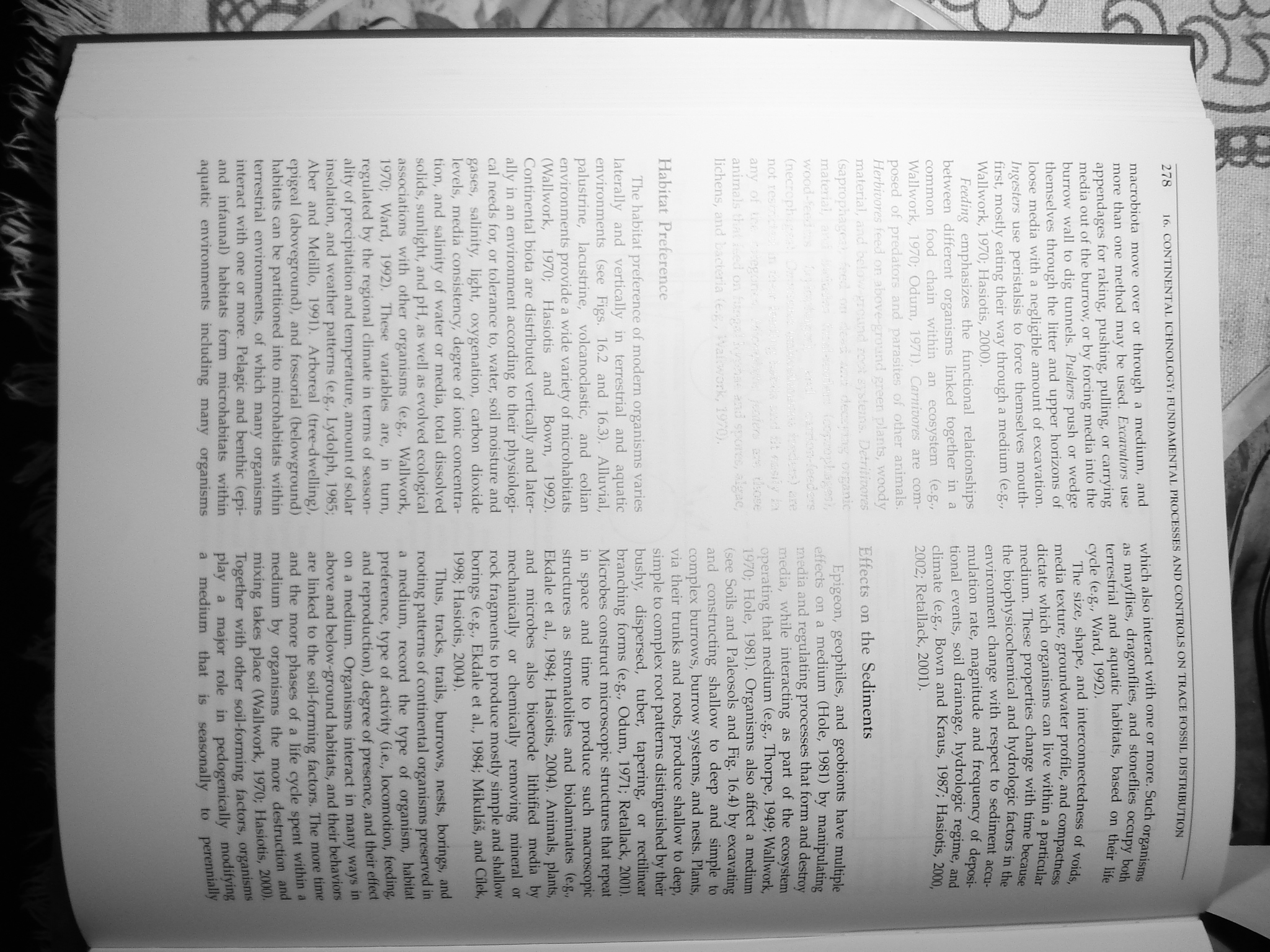dsc08794 (2)

278
16. CONTINENTAI. ICHNOLOGYi FUNDAMENTAL PROCESSES AND CONTROLS ON TRACĘ FOSSIL DISTRIBUTION
macrobiota mcve over or through a medium, and morę Mian one melhod may be used. Exowalom use appendages for raking, pushing, pulling, or carrying media out of the burrow, or by forcing media into the burrow wali to dig tunnels. Pushers pusli or wedge themselves through the litter and upper horizons of loose media with a negligible amount of excavation. Ingesters use peristalsis to force themselves mouth-first, mostly eating their way through a medium (e.g., Wallwork, 1970; Hasiotis, 2000).
Feeding emphasizes the functional relationships between different organisms linked together in a common food chain within an ecosystem (e.g., Wallwork, 1970; Odum, 1971). Carnivores are com-posed of predators and parasites of other animals. Herbwores feed on above-ground greer, plar.ts, woody materiał, and beiD'. gięund rcol Systems. Detritimres
animals that
lichens, and baeteria , Wahwork, 1970).
Habitat Preference
The habitat preference of modem organisms varies laterally and vertically in terrestrial and aąuatic environments (see Figs. 16.2 and 16.3). Alluvial, palustrine, lacustrine, volcanoclastic, and eolian environments provide a wide variety of microhabitats (Wallwork, 1970; Hasiotis and Bown, 1992). Continental biota are distributed vertically and laterally in an environment according to their physiologi-cal needs for, or tolerance to, water, soil moisture and gases, salinity, light, oxygenation, carbon dioxide levels, media consistency, degree of ionic concentra-tion, and salinity of water or media, total dissolved solids, sunlight, and pl I, as well as evolved ecological associations with other organisms (e.g., Wallwork, 1970; Ward, 1992). Thcse variables are, in turn, regulated by the regional climate in terms of season-ality of precipitation and temperaturę, amount of solar insolation, and weather patterns (e.g., Lydolph, 1983; Aber and Melillo, 1991). Arboreal (tree-dwclling), epigeal (aboveground), and fossorial (belowground) habitats can be partitioned into microhabitats within terrestrial environments, of which many organisms interact with one or morę. Pelagie and benthic (epi-and infaunal) habitats form microhabitats within aouatic environments including many organisms
which also internet with one or morę. Such organisms as mayflies, dragonflies, and stoneflies occupy both terrestrial and aquatic habitats, based on their life cycle (e.g., Ward, 1992).
The size, shape, and interconnectedness of voids, media lexture, groundwater profile, and compactness dictate which organisms can live within a particular medium. These properties change with time because the biophysicochemical and hydrologie factors in the environment change with respect to sediment accu-mulation ratę, magnitude and frequency of deposi-tional events, soil drainage, hydrologie regime, and climate (e.g., Bown and Kraus, 1987; Hasiotis, 2000, 2002; Retallack, 2001).
fects on the Sediments
Hpigeon, geophiles, and geobionts have multiple ts on a medium (Hole, 1981) by manipulating ic-dia and regulating processes that form and destroy dia, while interacting as part of the ecosystem lerating that medium (e.g., Thorpe, 1949; Wallwork, 970; Hole, 1981). Organisms also affect a medium e Soils and Paleosols and Fig. 16.4) by excavating and constructing shallow to deep and simple to complex burrows, burrow systems, and nests. Plants, via their trunks and roots, produce shallow to deep, simple to complex root patterns distinguished by their bushy, dispersed, tuber, tapering, or rectilinear branching forms (e.g., Odum, 1971; Retallack, 2001). Microbes construct microscopic structures that repoal in space and time to produce such macroscopic structures as stromatolites and biolaminates (e.g,, Ekdale et al., 1984; Hasiotis, 2004). Animals, plants, and microbes also bioerode lithified media by mechanically or chemically removing minerał or rock fragments to produce mostly simple and shallow borings (e.g., Ekdale et al., 1984; Mikulaś, and Cilek, 1998; Hasiotis, 2004).
Thus, tracks, trails, burrows, nests, borings, and rooting patterns of Continental organisms preserved in a medium, record the type of organism, habitat preference, type of activity (i.e., locomotion, feeding, and reproduction), degree of presence, and their effect on a medium. Organisms interact in many ways in above and below-ground habitats, and their behaviors are linked to the soil-forming factors. The morę time and the morę phases of a life cycle spent within a medium by organisms the morę destruction and mixing takes place (Wallwork, 1970; Hasiotis, 2000). Together with other soil-forming factors, organisms play a major role in pedogenically modifying a medium that is seasonally to perennially
Wyszukiwarka
Podobne podstrony:
dsc08789 (3) 276 16. CONTINENTAL ICHNOLOGYi FUNDAMBNTAL PROCESSES AND CONTROLS ON TRACĘ FOSSIL DISTR
dsc08779 (2) 70 16. CONTINENTAL ICHNOLOGY: FUNDAMENTAL PROCESSES AND CONTROLS ON T
dsc08786 (3) 274 16. CONTINENTAL ICHNOLOGY: FUNDAMENTA!. 1‘ROCESSES AND CONTROLS ON TRACĘ FOSSIL DIS
dsc08800 (3) 284 16. CONTINENTAL ICHNOLOGY: FUNDAMENTAL PROCESSES AND CONTROLS ON
dsc08787 (3) 274 16. CONTINENTAL 1CHNOLOGY: FUNDAMENTAL PROCESSES AND CONTROLS ON
dsc08776 (3) C H A P T E RContinental Ichnology: Fundamental Processes and Controls on Tracę Fossil
dsc08798 (3) 282 16. CONTINENTAL 1CIINOLOGY: PUNDAMENTAL PROCESSES AND CONTROLS ON TRACĘ FOSSIL DIST
dsc08784 (3) 272 16. CONTINliNTAI. K IINOI.OOYi RJNDAMIINTAI, PH0OUŚBHH ANI) ( ON
dsc08778 (2) FIGURĘ 16.1 Continental realm: biophysicochemical factors. Diagram depicts the and temp
A/CN.9/61 Page 50 NORWAY (continued) Major publications Books and articles on international law and
00017 Y3b1ecbc5ea50e4ab7e2c25f610b9c4 16 Woodall & Faltin Wheeler (199la) and Griffith (1989).
CCF20110228�000 (6) Z plazmą w zębach 16-06-2009 18:20 W najnowszym numerze Plasma Processes and Po/
00216 ?e7b2021092421cf45af4c94abbb03e 218 Baxley where the a, ’s are NID(0, a]) representing random
00394 ?4bf53b90d85a9db56d6772e2aee78a 398 Obenchain Table 4. Yields for Processes with Mean on Targ
00469 ?5193b0eebc921358b059bb4bde7465 475 An Algorithm and a Graphical Approach for Short Run Proce
Tuesday continued hla prowoto •» • Joyar. and *ot tor hit •b*ry aaanacior. (8) FAITH20 8:33 (17)
Liczba cytowan: 2 Cytujący: 1. Horska E.; Oremus P. / 2008 / Processes and problem
więcej podobnych podstron